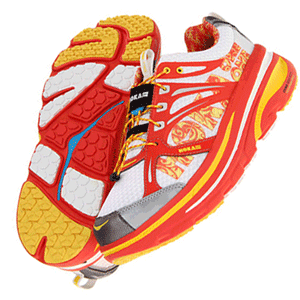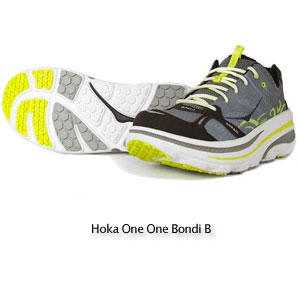
Hoka One One is a perennial topic on the ST forum. A frequently asked question is how the Bondi and Stinson (pictured adjacent) compare to each other, particularly in how they fit.
Here are the results of some months of running in each.
Stinson Tarmac
The Stinson offers what Hoka calls Ultimate Protection. That means the midsole is the thickest you will find on any Hoka. Under the heel is 32mm of stuff – midsole and outsole – and under the forefoot it’s 26mm thick, hence a low but not awfully low drop 6 mm. The shoes come with 2 different insoles, aka sock liners. The first is 4mm thick and is what you’ll find in most running shoes. The second is a 2mm all flat insole that will provide you with some extra room in the shoe if you wider than average feet.
The lacing is also available in two different styles. Standard in the shoe is the Quick Lace system that consists of a thin, non-elastic lace with a speed closure. Personally I didn’t like the system, but I don’t like almost any of those speed lace systems available. It should be noted that this is not a system built for triathletes, though it looks very much like a speed lace system you’d expect to see in a tri shoe. This closure came from the ultra running community, to keep the shoe from getting loose and sloppy in its fit, especially if the shoe gets wet. Remember, Hoka began as a shoe for ultra runners by ultra runners, hence this closure system.
That’s the explanation for this lacing system, but it never seemed to give me the fit I can achieve with normal laces. If your shoe comes with this lacing system and you don’t want it you can’t save the system for some other use – you must cut the laces to get the laces out of the shoe.

Although the Stinson Tarmac is the tallest road shoe in the Hoka collection (the mostly-trail Mafate is very slightly taller) it looks actually lower than the Bondi 2 (pictured adjacent). The midsole doesn’t wrap around and up the side and back of the shoe to the degree it does in the Bondi. This illusion makes the Bondi look like a taller shoe and a shoe with more drop than it has.
Does the Stinson and, indeed, do all the Hokas, feel weird? Yes, they do. The first time you run in them they feel so cushioned, unlike anything you tried before. I’m the shoe reviewer here, I write most of the shoe reviews, I own a footwear retail store, and I run a lot. Even so, these shoes are like nothing I’ve ever run in before. Maybe the old Nike Shox comes close. But after a few miles in I started to get used to the feeling and I had no problem whatsoever to maintain what is for me a normal midfoot strike and a normal cadence of about 85 to 90 steps per leg per minute. It felt just as easy to maintain this posture and form as in a Newton or any lower drop, less cushioned shoe.
The upper is wide enough for my feet and it would accommodate feet wider yet than mine. There are 2 elastic straps that are attached on each side of the upper between the laces. For me they had no function they were rather in the way of getting my laces how I like them so I cut them out.
When you look from the back, the midsole forms a trapezius, that is, it’s wider at the base of the shoe than directly under the upper. In the Bondi there’s less of that – the midsole is more straight up and down – and that’s reflected in the dimensions below.
The Bondi 2
This is what Hoka calls Full Protection (as opposed to the Tarmac’s Ultimate Protection). The midsole is 29mm under the heel and 24.5 under the forefoot yielding a drop of 4.5mm. The upper is made from a different mesh material than with the Stinson Tarmac. It comes with only the 4mm insole and standard laces. If you like to have a speedier T2 you should replace those with a Yankz! or other speedlace system.

The upper on the Bondi is wider in the toebox than in the Stinson, and not only wider but higher, so, more room above the toes as well as between them. The Bondi differs mightily from the Stinson in the midsole. The Bondi wraps around the shoe and creates a sort of cradle or box shape that will give you extra stability, specifically stability in the lateral plane. Note that the Bondi B 2 will fit a little less snugly than the original Bondi B. The original Bondi B employed a fully sewn overlay construction. The blue model pictured just above, which is the Bondi B 2, is constructed with “no sew” overlays. With “no sew” overlay construction there will always give a roomier fit, as the synthetic overlay piece that gets heat/pressure bonded to the mesh base does not have a “backer” to it that traditionally used synthetic overlays. These overlays that are sewn down to mesh bases reduce stretch. This means that although the current Bondi models are built on the same last, same patterns, those who scratch their heads and wonder how the new Bondi can be described as “roomy” now have their explanation.
I found the Stinson to be just a little less bouncy than the Bondi and although it’s got more midsole it gave me a more stable feeling than I had in the Bondi. But if you do like to have the most cushioned, springy and bouncy feeling you should go for the Bondi. My experience differs from the Slowtwitch publisher Dan Empfield, who finds the exact opposite in terms of stability. While I can run in a neutral shoe Dan cannot, and feels the cradling midsole gives the Bondi that stability in the lateral plane that allows the Bondi to snugly hold up an orthotic and keep the foot precisely in place.
The Bondi feels also lighter than the Stinson, much lighter than the 30 grams difference there actually is between those shoes. A Stinson comes in at 320 grams (11.9 oz) in a men’s 8.5 and the Bondi at 290 grams (10.8 oz). But the feeling of the Bondi being lighter is much larger than that. Dan thinks that is precisely because of that lateral stability that is a hallmark of the Bondi.
The Bondi also has a bit of a different geometry that might cause one to feel speed in this shoe if one runs at higher speeds. The Bondi has the “rocker” a bit rearward versus the Stinson, which means those who wish to transition from footplant to push-off quickly have the shoe’s geometry working in its favor.

We did a lot of gait analysis on both Hoka One One models and this, along with some customer feedback, tells us that some over-pronators experience blister forming and rubbing on the medial side of the foot, where the ball of the foot is, or a little rearward, higher up the arch. Especially with the Bondi (a women's colorway is adjacent). I experienced this myself. And although we can call the Hokas stable, there might be a gap in the Hoka collection – there is no supportive shoe in their range. A shoe with a dual density post to give the runners who pronates more than average just that extra notch of support.
It should be noted this is another point of disagreement between the Slowtwitch footwear editor (me) and the Slowtwitch publisher. Dan thinks these blisters in the arch some experience are precise proof of that stability, that is to say, the Bondi is so stable a previously unsupported part of the foot is now in contact with the shoe, maybe for the first time in a long time, hence the blister.
The Stinson measures a whopping 98.5 mm wide sole at the base under the heel and the Bondi at that same point 95 mm. Under the midfoot the Stinson measures 85.1 mm to 84.9 mm for the Bondi and the widest point at the base of the forefoot is for the Stinson 105mm to the Bondi at 109mm. But in the case of the Bondi it’s so wide due to the different wrapping around the upper. We took those measurements on women’s size 9 shoes. The differences aren’t that large but the Stinson seemed to have some more torsional stiffness than the Bondi.
The Stinson’s upper seems to hold water longer than the Bondi. The Stinson felt soggy in a rainy run, and ran heavier in wet conditions than the Bondi. This compared with the lighter feeling of the Bondi makes me think this is the shoe to race in - unless the Stinson just fits you better than the Bondi.
Both shoes are extremely protective and absorb shock at an unbelievable level. I have never felt anything like those shoes in my entire running career. Some Slowtwitch forum members disagree but I felt they keep that cushy feeling a long time, and durability doesn’t seem to be that much of a difference between both models. I ran about 500 miles in each model, mostly on asphalt and hard trails.
Hokas are not for everyone, but no other running shoe model or brand is. But if you need all the cushioning you can get there is no doubt that Hoka will deliver. You will not like the Bondi B 2 and the Stinson equally – you will choose one over the other.
Both models come in different colors and in men and women specific size as well as in unisex sizes so make sure which one you need to have.
This brand tops out at size 14 in mens, and 11 for women.
We see nothing from Hoka indicating that these shoes are stability or motion control shoes. They seem to be considered neutral shoes, and they work fine as neutral runners. However, Dan vehemently disagrees, especially in the case of the Bondi. He thinks that, while this model has no traditional stability features, like dual density midsoles or medial posts – which makes this shoe popular for those looking for neutral shoes – the midsole “wrap” of the upper gives this shoe exceptional stability for over-pronators. Hoka calls them “neutral stability” shoes. So, we’re marking these as neutral shoes, just bear in mind that this company makes shoes that do not play by the rules that the footwear industry has laid down for the past generation, and as such they defy typical categorizing.
[Editor’s note: Our capable editor-at-large for footwear Jeroen van Geelen owns Total Running, one of the more important running and triathlon retail establishments in The Netherlands.]


